Related Research Articles

The Forest of Dean is a geographical, historical and cultural region in the western part of the county of Gloucestershire, England. It forms a roughly triangular plateau bounded by the River Wye to the west and northwest, Herefordshire to the north, the River Severn to the south, and the City of Gloucester to the east.
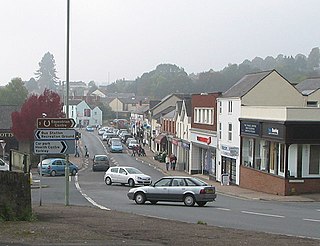
Lydney is a town and civil parish in Gloucestershire, England. It is on the west bank of the River Severn in the Forest of Dean District, and is 16 miles (25 km) southwest of Gloucester. The town has been bypassed by the A48 road since 1995. The population was about 8,960 in the 2001 census, reducing to 8,766 at the 2011 census. Increasing to 10,043 at the 2021 Census.
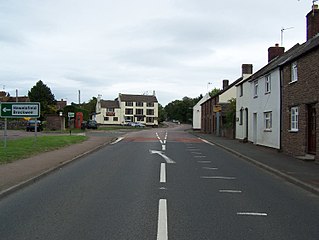
Alvington is a village and civil parish in the Forest of Dean in Gloucestershire, England, situated on the A48 road, six miles north-east of Chepstow in Wales. The parish had a total population of 506 at the 2011 census.

Admiral Sir William Wynter held the office of Surveyor and Rigger of the Navy for 40 years, from 1549 until his death in 1589, and combined that with the office of Master of Navy Ordnance from 1557. He was an admiral and principal officer of the Council of the Marine under Queen Elizabeth I of England and served the crown during the Anglo-Spanish War (1585–1604). He was returned four times to parliament in Elizabeth's time.

English Bicknor is a village and civil parish in the Forest of Dean district of west Gloucestershire, England. The 2011 Census recorded the population as 408. The village is near the county boundary with Herefordshire, opposite which is the village of Welsh Bicknor. The two villages are on opposite sides of the River Wye.

Clearwell is a village and former ancient manor in the Forest of Dean, West Gloucestershire, England. A recent survey indicated that the population of Clearwell is approximately 350.

Purton is a hamlet on the west bank of the River Severn, in the civil parish of Lydney in Gloucestershire, England. It lies opposite the village of Purton near Berkeley on the east bank of the river.

Sir Robert Atkyns, was a topographer, antiquary, and Member of Parliament. He is best known for his county history, The Ancient and Present State of Glostershire, published in 1712.
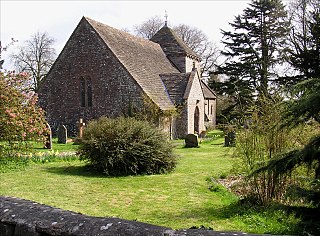
Hewelsfield is a village in Hewelsfield and Brockweir civil parish, in the Forest of Dean district of Gloucestershire, England.
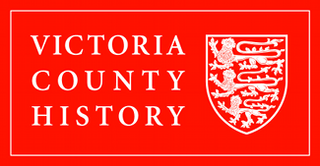
Gloucestershire Victoria County History is an encyclopaedic history of the county of Gloucestershire in England. It forms part of the overall Victoria County History of England founded in 1899 in honour of Queen Victoria. With twelve volumes published in the series A History of the County of Gloucestershire, the Gloucestershire Victoria County History is about halfway through its history of all the parishes in the county. Ten volumes have been published to date, and a further four volumes are in preparation.

Sir Baynham Throckmorton, 3rd Baronet of Clearwell, Gloucestershire was an English politician who sat in the House of Commons at various times between 1656 and 1679.

Bledisloe was an ancient hundred of Gloucestershire, England. It comprised the ancient parishes of

St Briavels was an ancient hundred of Gloucestershire, England. It comprised the extra-parochial area of the Forest of Dean, and the ancient parishes of

Sir Baynham Throckmorton, 2nd Baronet, of Clearwell, Gloucestershire, supported the Royalist cause during the English Civil War and was a Member of Parliament for Gloucestershire from 1661 until his death on 28 May 1664.
Sir John Winter or Wintour was an English ironmaster and landowner at Lydney in Gloucestershire, who was an ardent supporter of Charles I during the English Civil War.
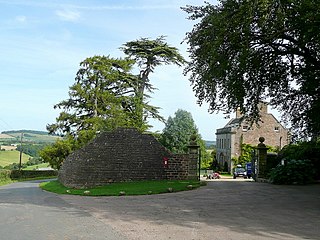
Eastbach Court is a historic Grade II listed mansion in English Bicknor, Gloucestershire, England.
Samuel Blackwell was a British politician who sat in the House of Commons from 1774 to 1784.
White Cross Manor was the manor house in Lydney, Gloucestershire, England, of the Wynter family. It was burnt to the ground in April 1645 on the orders of Sir John Wynter to avoid it being taken over by the Parliamentarians during the English Civil War.

Lydney Town Hall is a municipal structure in the High Street, Lydney, Gloucestershire, England. The structure, which is used as an events venue, is listed by the local authority as a "building of local architectural or historical interest".
Cantref Coch was a cantref associated with the kingdoms of Ergyng, Gwent and the later Kingdom of Glamorgan. Its area is defined as the land between the River Severn and the River Wye, with the Severn Sea as its southern border although its northern border is less certain. Cantref Coch is one of the few medieval cantrefi named by Welsh writers that is not within the modern nation of Wales.
References
- 1 2 3 4 M.R.P., 'Wynter, Edward (c.1560-1619), of Lydney, Glos.', in P.W. Hasler (ed.), The History of Parliament: the House of Commons 1558-1603 (from Boydell and Brewer 1981), History of Parliament online.
- ↑ A.P. Baggs and A.R.J. Jurica, 'Lydney: Manors and other estates', in A History of the County of Gloucester, Volume 5: Bledisloe Hundred, St. Briavels Hundred, the Forest of Dean, ed. C.R.J. Currie and N.M. Herbert (V.C.H., London 1996), pp. 46-84 (British History Online, accessed 21 April 2021).
- 1 2 'Wynter. Pedigree No. 1 and No. 2', in J. Macleane and W.C. Heane (eds), The Visitation of the County of Gloucester taken in the year 1623, (&c.), Harleian Society XXI (1885), pp. 271-78, at p. 273 (Internet Archive).
- ↑ 'Winter, (Sir) Edward (Wynter)', in J. Foster (ed.), Alumni Oxonienses 1500-1714 (Oxford 1891), pp. 1654-74 (British History Online, accessed 19 June 2023).
- 1 2 3 4 W.R. Williams, Parliamentary History of the County of Gloucester (Author, Hereford 1898), pp. 47-48 (Internet Archive).
- ↑ M.F. Keeler (ed.), Sir Francis Drake's West Indian Voyage, 1585-86, The Hakluyt Society (London 1981), p. 280, p. 299-300, and passim (Google Preview).
- ↑ 'Letter from Edward Wynter to Sir Francis Walsyngham. 24 August 1588', in 'Proceedings of the Central Committee, September 10 1845', Journal of the British Archaeological Association I (London 1846), pp. 309-46, at pp. 321-23 (Google).
- ↑ Will of Sir William Wynter of Lydney, Gloucestershire (P.C.C. 1589, Leicester quire).
- ↑ Baggs and Jurica, 'Lydney: Manors and other estates', V.C.H. Gloucester V (1996), pp. 46-84, at note 355 (British History Online), citing The National Archives (UK), 'Inquisitions post mortem (Chancery), Gloucestershire: Winter, Sir William (17 November 1589-16 November 1590),' ref. C 142/227/204 (Discovery Catalogue).
- 1 2 '4. Edward Swarthye, the Porter', in M. Kaufmann, Black Tudors: The Untold Story (Simon and Schuster, 2017), pp. 90 ff (Google Preview).
- ↑ 'Sir Robert Cecil and Sir John Wolley to Edward Wynter. 22 April 1593', and 'Edward Wynter to Sir Robert Cecil and Sir John Wolley. 14 May 1593', in Calendar of the Manuscripts of the Most Hon. the Marquis of Salisbury, at Hatfield House, Part IV (Royal Commission on Historical Manuscripts, HMSO 1892), pp. 302-03, pp. 313-14 (Google).
- ↑ J. Strype, Annals of the Reformation and Establishment of Religion, New Edition (Clarendon Press, Oxford 1824), III Part 2, pp. 38-40 (Google). Letter misdated 1588, recte 8 July 1592.
- ↑ J. James, 'DCCCLXXXVI. Notes on Lydney and its dependencies', Gloucestershire Notes and Queries: An Illustrated Quarterly II (Wm. Kent & Co., London 1884), pp. 493-505, at p. 501 (Google).
- ↑ Clergy of the Church of England database, ref CCEd Location display 9418.
- ↑ Clergy of the Church of England database, ref CCEd Person ID 134377.
- ↑ C. Elrington, 'List of Sheriffs of Gloucestershire', in Transactions of the Bristol and Gloucestershire Archaeological Society 128 (2010), pp. 207–227 (Society's pdf), at p. 216.
- ↑ Baggs and Jurica, 'Lydney: Manors and other estates', V.C.H. Gloucester V (1996), pp. 46-84, at note 357 (British History Online), citing Gloucester Record Office D 421/E 3, and C.E. Hart, Royal Forest. A History of Deans Woods As Producers of Timber (Clarendon Press, Oxford 1966), p. 86.
- ↑ 'Sir Edward Wynter to the Lord Admiral and Sir Robert Cecil. 6 February' (attributed date 1595/96), in 'Cecil Papers: February 1596, 1-15', in R.A. Roberts (ed.), Calendar of the Cecil Papers in Hatfield House, Vol. VI: 1596 (HMSO, London 1895), pp. 43-58 (British History Online, accessed 18 June 2023). ?Date endorsement possibly incorrect.
- ↑ A.P. Baggs and A.R.J. Jurica, 'Forest of Dean: Industry', in C.R.J. Currie and N.M. Herbert (eds), A History of the County of Gloucester, Vol. 5: Bledisloe Hundred, St. Briavels Hundred, the Forest of Dean (V.C.H., London 1996), pp. 326-354 (British History Online, accessed 22 June 2023).
- 1 2 'Winter', in H.G. Nicholls, The Personalities of the Forest of Dean (John Murray, London 1863), pp. 112-27, at pp. 113-17 (Google): citing Lansdowne MSS, No. 166/94 (British Library Archive search), fols. 340, 344, 346.
- ↑ cf. The National Archives (UK), Wyntour v Cachmay ref. STAC 8/303/7 (Discovery Catalogue).
- ↑ S. Sandall, '"They call their neighbours cowards for not assisting them": Custom, neighbourliness and popular resistance in early modern England', in B.C. Kane and S. Sandall (eds), The Experience of Neighbourhood in Medieval and Early Modern Europe, Studies in Medieval History and Culture (Routledge, Abingdon/New York 2022), pp. 88-104 (Google preview).
- ↑ See also S. Sandall, Custom and Popular Memory in the Forest of Dean, c.1550-1832 (Scholars' Press, 2013).
- ↑ The National Archives (UK), Exchequer: Surrender by Sir Edward Wyntour of Lydney, ref. E 214/809 (Discovery Catalogue).
- ↑ Baggs and Jurica, 'Lydney: Manors and other estates', V.C.H. Gloucester V (1996), pp. 46-84, at note 358 (British History Online), citing The National Archives (UK), 'Inquisitions post mortem (Chancery), Gloucestershire: Winter, Sir Edward (24 March 1619-23 March 1620),' ref. C 142/378/147 (Discovery Catalogue).
- 1 2 'Winter of Lidney', in T.F.P. Fenwick and W.C. Metcalfe (eds), The Visitation of the County of Gloucester, begun by Thomas May, Chester, and Gregory King, Rouge Dragon, in Trinity Vacacon 1682, and finished by Henry Dethick (for Mr. Fenwick, Exeter 1884), at pp. 205-06 (Hathi Trust).
- ↑ (T. Cecil, engraver), A Relation of Maryland together with a map of the countrey, the conditions of plantation, his Majesties charter to the Lord Baltemore, translated into English (William Peasley, London 1635), at p. 56 (Umich/eebo).
- ↑ E.D. Neill, The Founders of Maryland as Portrayed in Manuscripts, Provincial Records and Early Documents (J. Munsell, Albany 1876), at p. 49 and p. 64 (Umich/eebo).
- ↑ For Hall's monumental inscription, see J. Fendley (ed.), Notes on the Diocese of Gloucester by Chancellor Richard Parsons, Gloucestershire Records Series 19 (Bristol and Gloucestershire Archaeological Society, 2005), at p. 179 (Google snippett).
- 1 2 C. Heywood, ed. J. Gillow, 'Records of the Abbey of Our Lady of Consolation at Cambrai, 1620-1793', Catholic Records Society Vol. 13: Miscellanea VIII (London 1913), pp. 1-85, at p. 47, p. 80 and p. 84. Reader at issuu.com.
- ↑ J.S. Hansom (ed.), 'III. The Register Book of Professions, etc., of the English Benedictine nuns at Brussels and Winchester, now at East Bergholt, 1598-1856', Catholic Record Society, Vol. 14: Miscellanea IX (London 1914), pp. 174-203, at p. 184. Reader at issuu.com.
- ↑ I.B. Watson, 'Winter, Sir Edward (1621/2–1686)', Oxford Dictionary of National Biography (OUP 2004). Online edition 2008.